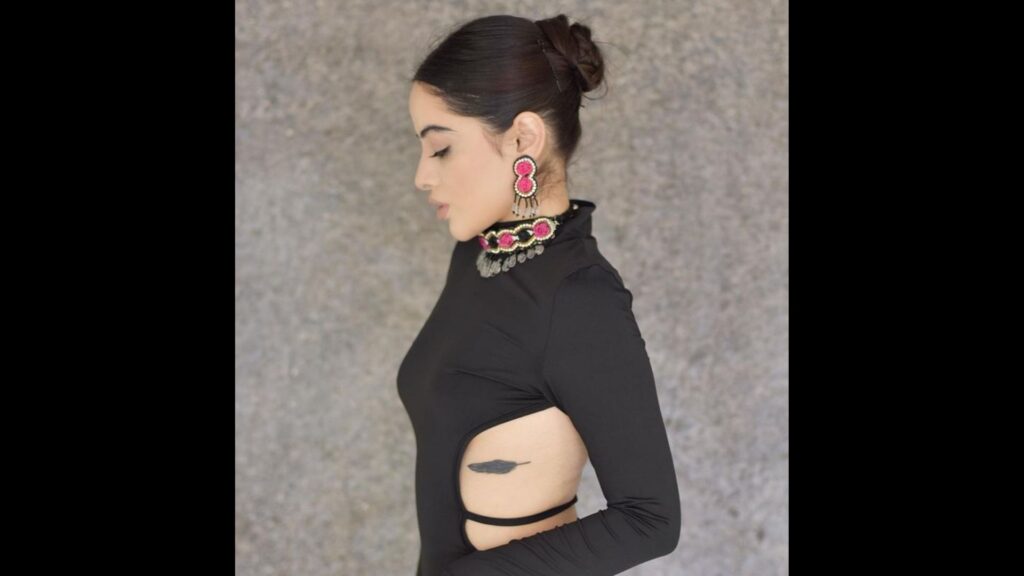



Urfi Javed. In today’s world, her name doesn’t just bring to mind the image of a TV actress or an influencer — it brings a wave of questions, opinions, and emotions. She’s not merely a celebrity anymore; she has become a conversation. A walking question mark. A mirror to society’s hypocrisy.
While the fashion industry globally is wrapped in elegance, rules, and often a deep fear of non-acceptance, Urfi is walking right through the center of it wearing a dress made of chains, or sometimes, nothing but caution tape. And she does it with the same ease that others wear a designer gown.
But this isn’t just shock value. It’s not just a gimmick. What Urfi is doing with fashion is far deeper than most are willing to admit — even her critics. She’s speaking a language not everyone understands. A language where fabric becomes freedom, and where boldness becomes a kind of truth-telling.
Born in Lucknow in 1997, Urfi Javed’s path began much like thousands of aspiring actors in India — small TV roles, limited screen time, and barely any headlines. But what makes her story different is what she chose to do when no one was watching. She didn’t wait for a big film. She didn’t try to fit into the mold of “ideal heroine” or “fashion icon”. She created her own category — unapologetic, unpredictable, and unfiltered.
She started designing and wearing outfits that no stylist in Mumbai would dare suggest. She wore clothes made of safety pins, glass pieces, mobile phone wires, garbage bags, and even flower petals. But more importantly, she wore confidence — a kind that refused to be tamed.
In India, the word atrangi is often used for something that doesn’t fit in — something too loud, too strange, too different. For women especially, being “atrangi” has always been a warning sign. Don’t be too loud. Don’t be too bold. Don’t wear something that draws too much attention.
Urfi turned that insult into a badge of honor.
She made atrangi fashionable.
Every time she steps out wearing something bizarre, the internet splits into two. One side mocks her. The other defends her. But both sides are watching her. That’s power. That’s impact.
She’s not just challenging fashion norms — she’s challenging who gets to decide what’s “acceptable”. Who sets the rules for a woman’s body? Who defines elegance? Why should fashion always be beautiful — why can’t it be uncomfortable, raw, even disturbing?
Many assume Urfi’s fashion is about seeking attention. But if you look closer, her outfits are often political. They reflect ideas like freedom of expression, body autonomy, censorship, slut-shaming, mental health, and even the toxic nature of celebrity culture. She has said more through a 30-second video in a handmade outfit than many influencers do in a thousand perfectly-filtered posts.
She’s angry. She’s hurt. She’s liberated. And she’s using fashion as her form of protest. In a society that still struggles with the idea of women choosing their own clothes, Urfi has taken that choice to the extreme — and in doing so, exposed the uncomfortable truths underneath our polished culture.


In one of her most talked-about outfits, Urfi wore a dress made entirely from fake razor blades. The visual was sharp, metallic, and uncomfortable. It wasn’t glamorous. It was dangerous. But if you truly looked — not just with the eyes, but with understanding — the dress was a metaphor.
It spoke of the pain women carry silently. Of how society cuts you with words, stares, judgments. How every woman is expected to be soft and beautiful, yet strong enough to endure a thousand wounds. Urfi didn’t say any of this out loud. She let the metal do the talking.
Some called it “disgusting.” Others saw poetry in the violence.
And that’s exactly what she wanted — to make people confront what they usually scroll past.
Another outfit that left the internet divided was when she wrapped herself in a clear plastic sheet — no designer label, no makeup-heavy shoot, just raw exposure. It was uncomfortable to look at. Which was the point.
This wasn’t just nudity. It was a question.
How much do you want to see before you’re satisfied? If you consume women’s bodies on screens, in ads, in films — why is this any different? Why is it offensive now? The plastic wrap wasn’t fashion. It was commentary. On voyeurism. On digital objectification. On shame.
And as always, the trolls came first. Then the applause.
Urfi doesn’t need validation. But she forces everyone to examine their own double standards.
One of her most intelligently crafted designs was a skirt made entirely from old SIM cards. It looked funny at first — a little DIY, maybe even absurd. But once you thought about it, it hit harder than expected.
The SIM cards symbolized surveillance. Digital identity. How every action, every move, every word of hers is tracked, saved, commented on, and often misinterpreted. For Urfi, privacy is a privilege she never had. And the skirt said it loud: “If I’m going to be watched, I’ll choose how I’m seen.”
What looked like madness, was actually protest.
For every outfit, there’s a flood of reactions.
On Instagram: thousands of comments—some cruel, some supportive, most confused.
On YouTube: influencers breaking down her style like it’s a crime scene.
On news channels: panelists debating whether she’s destroying Indian culture.
But all of them — every last one — are giving her what she’s mastered: attention.
Urfi understands today’s world better than most. Outrage spreads faster than approval. Discomfort travels quicker than comfort. And the more she’s criticized, the louder her message becomes.
She is not trying to be accepted. She is forcing people to choose a side. To think. To react. To feel.
That’s not fashion. That’s performance art.
Urfi’s Instagram comments are a minefield of hate. “Shameless.” “Disgrace to the nation.” “She needs a doctor.” And that’s putting it mildly. Every time she posts a photo, it comes with a guaranteed flood of personal attacks, death threats, moral lectures, and casual cruelty. Not because she said something hurtful. Not because she harmed anyone. But simply because she wore what she wanted to.
Most people scroll past these comments. Urfi doesn’t have that privilege. She sees them. Lives them. Absorbs them.
And she has said in multiple interviews — it gets to her.
She’s human.
No one is immune to a thousand people telling you every day that you are wrong, ugly, worthless, or disgusting. Especially when all you’re doing is expressing yourself.
Fame can be isolating. But controversial fame is even more brutal. Urfi doesn’t fit in the influencer circle — they either mock her or keep a safe distance. She doesn’t belong to the traditional Bollywood club either, where designer gowns and politically correct statements rule the red carpet.
She’s a misfit. And misfits often walk alone.
When you are the only one doing something different — not because it’s trendy, but because it’s your truth — you carry a deep, invisible loneliness. Even in rooms full of flashing cameras, you can feel like the only person who isn’t allowed to be comfortable.
Urfi is invited to parties. But rarely is she truly welcomed.
And yet, she keeps showing up. In something no one expects.
Because silence, for her, would be the bigger pain.
Behind the defiance is a girl who’s been through trauma. Urfi has openly shared stories from her past — toxic relationships, a difficult upbringing, and moments where she felt invisible. In many ways, her fashion is her way of reclaiming that voice. Of saying, “You didn’t see me then. You can’t ignore me now.”
Despite public perception, Urfi is spiritual. She’s often posted about her faith in a higher power, in karma, and in emotional healing. She reads. She reflects. She meditates. Because even the loudest rebels need quiet corners to breathe.
The outer boldness isn’t a performance. It’s armor.
An armor she built herself.
There have been days where Urfi has broken down. She’s admitted to crying after harsh headlines, losing sleep over unnecessary trolling, and questioning her own choices.
But here’s the difference — she chooses to come back.
Every look she posts, every walk in front of the paparazzi, every moment where she knows judgment will pour in — is a choice to keep fighting. Not for fame, but for freedom. Not to shock people, but to stay seen. To stay heard.
In a world constantly trying to erase her, Urfi Javed is writing herself back into the frame — every day, one uncomfortable outfit at a time.

Every few days, a media outlet publishes something like:
What’s missing in almost every piece? Why she wore it. What inspired it. What message it carried. There’s no exploration of the story behind the statement — only the spectacle. The media knows that her name guarantees traffic, but rarely do they extend her the dignity of depth.
Urfi is covered like a controversy, not like a creator.
Ironically, the same media that shames Urfi for “destroying Indian culture” also celebrates international celebrities for similar expressions. When Lady Gaga wore a meat dress or Doja Cat covered herself in red crystals, Indian media called it “art” and “bold couture.”
But when Urfi wears a handmade concept outfit in Mumbai, it becomes “vulgar” or “embarrassing.”
Why?
Because she’s an Indian woman doing it in a country where tradition still expects modesty, silence, and simplicity from its women — especially if they don’t come from privilege.
Urfi’s background doesn’t protect her. She isn’t the daughter of a superstar or the face of a designer label. She’s self-made — and that makes her an easier target.
Several news channels have dragged Urfi into primetime debates, where panelists shout over one another about Indian culture, women’s dignity, and social responsibility — all triggered by a piece of fabric she chose to wear.
What’s often ignored in these debates is Urfi’s right to choose.
Her clothes become symbols — but no one bothers to hear her speak.
She’s rarely invited to these discussions. And if she is, it’s never for her design thinking, her courage, or her social message. It’s to provoke reactions and raise TRPs.
The irony? While mocking her, they amplify her.
Every now and then, something shifts.
In those moments, the headlines change. The tone softens. The world glimpses her beyond the clothes — and they find a thinker, a survivor, a strategist.
But the respect is temporary. As soon as she posts a new “atrangi” outfit, the cycle of mockery returns.
Here’s the twist: Urfi knows exactly what the media is doing — and she plays along, but on her own terms.
She posts knowing the headlines will follow. She gives photographers exactly what they want — and makes sure her message is baked into the visual. She uses controversy as currency. She has turned trolling into traction. And she has never needed a PR team to stay relevant.
Where others rely on marketing agencies, Urfi has created her own media ecosystem — fueled by outrage, but controlled by her.
Urfi Javed may be introduced to the world as an “influencer,” “actress,” or “controversial dresser,” but those labels are far too small to hold the truth of who she is. In a country where tradition often dictates appearance, where women are taught to blend in, and where rebellion is punished with silence — Urfi Javed has chosen to be loud.
Not through words. But through fabric, metal, glass, plastic, rope, tape, and courage.
She has dismantled the boundaries of what fashion is “supposed” to look like. She has taken the language of judgment and turned it into a mirror. She has faced hate, mockery, and moral policing — not by fighting it, but by continuing to show up exactly as she is.
In doing so, she has inspired thousands — especially young women — to stop shrinking themselves to fit expectations. To wear what they want. Say what they feel. And exist without seeking permission.
Urfi Javed is not just a disruptor of trends. She is a disruptor of systems.
Whether you love her, hate her, or don’t know what to make of her — you cannot ignore her. And maybe that’s her greatest power. In a world full of polished images and carefully curated perfection, she reminds us of something far more radical: